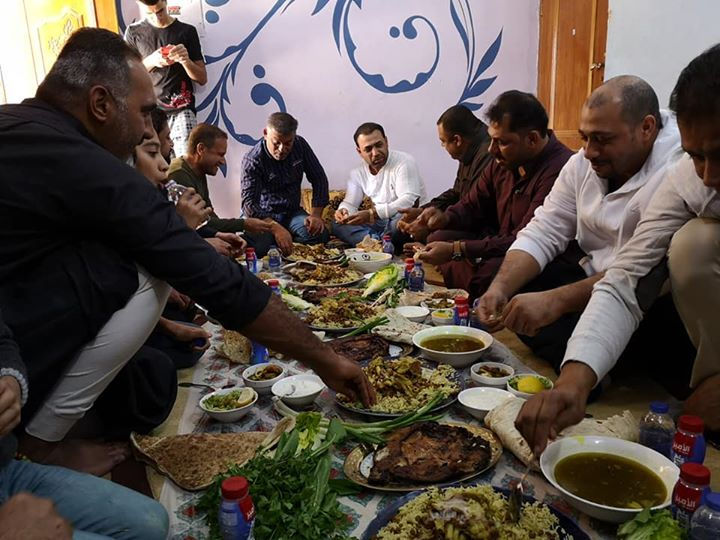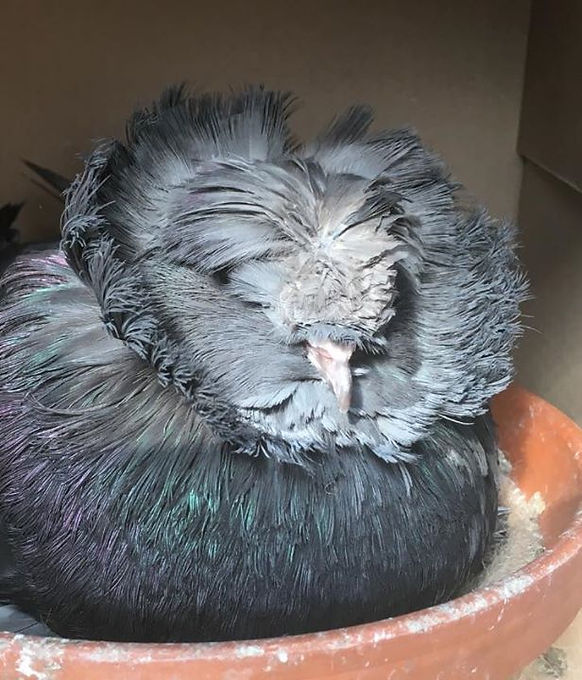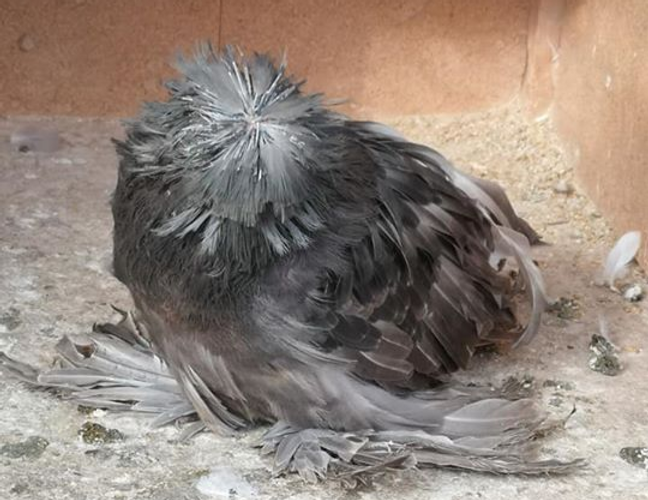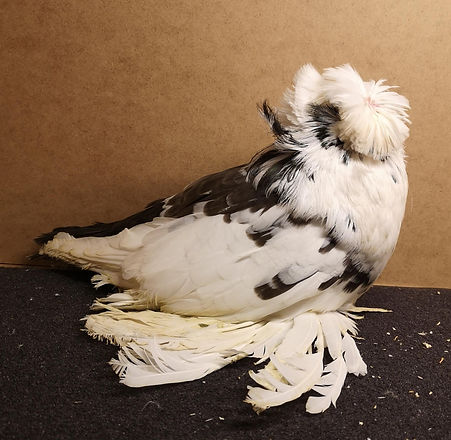THE YEAR IN THE LOFT
The new season begins around mid January any given year. That is when the show season is over and we get the urge to breed.
On this page I will try and cover how I keep the Bokharas and how I got about the breeding.

THE CALENDAR
Living in the northern hemisphere and breeding to try and improve, show and promote Bokharas my pigeon year is strictly divided into the periods here mentioned listed hereunder.
FEBRUARY - JULY
This is the breeding season. All young birds are bred during this period. In order for a young Bokhara to be show ready for that year's shows it must in generally be hatched before April 10th, especially if it is a good one.
AUGUST - NOVEMBER
These are the main moulting months.Not many Bokharas will look like much before October 1st. The sexes are split during this time, cocks and hens apart to aviod delays in moult, fightings and unwanted stress. This period is the most important in the life of a Bokhara as they build stamina for a cold winter and beauty for the pleasure of the eyes and show condition.
DECEMBER - JANUARY
Show season. The season where the truth reveals itself when your birds go up against those of other breeders. Many of your birds will look better in your own loft than in honest competition. It is a time of fellowship, fun and admiration and the backbone of the concept "Fancy Pigeons"
I attend many shows worldwide every year, mostly as a spectator or judge. I show only when there is a good chance of being beaten meaning that your birds went up against the very best.

FRIENDSHIP THROUGH PIGEONS, IN THE HOME OF NAIEM GAZI IN BASRAH; IRAQ
PURE BOKHARA LOVE AND FUN
THE SHOW SEASON IS OVER
Breeding preparations
The serious breeder actually began in november preparing the new season. Not in the Bokhara loft, but in the feeder loft. Healthy feeders in a controlled environment is the key to a successful Bokhara breeding season. Only amateurs shop or organize feeders in the breeding season. Your Bokhara eggs will be worthless if you got no healthy feeders to place them under as the chance of the young bird will never make it from the nest is pretty big.
Most people failing at keeping Bokharas fail in 2 areas - getting fertile eggs and turning the fertile eggs they do get into adulthood.
Feeder facts
Make sure you got an even number of cocks and hens. That they are mature enough to breed.
That each pair has a nest - that means that each pair actually lives in that nest and no fighting over nests go on.
No unmated birds allowed in the feeder loft.I do not recommend random medication but depending on your location you may or may not have access to veterinary service for testing and treatment. If your feeders do not appear right, get them right. E-Coli, Salmonella, Hexamitosis, and Trichomoniasis are your main concerns. These will eventually lead to poor growth of young and deaths. Typically the first round will be somewhat ok, the problems emerge in subsequent rounds.
And this is a good idea - let your feeders breed a round of test young to see the stage of things. If these grow up well and fat assume the feeders are healthy. I do this.
Which feeders are good? I use racing homers. People will tell you all kinds of tales of different fancy breeds being qualified feeders. Most are not true. The choice is yours. Health is your main concern, not if the feeder is a racing homer or a King cross. The serious breeder knows this. If you got feeders which neglect the young show no pardon on them. Your job is to determine if they did actually neglect them or you got health issues in the flock.'
Look and learn from your mistakes. Making mistakes is ok, not learning from them is stupidity.
THE HEALTHTY LOOK
DAN 232-16-2479
Racing homer cock from my racing team displaying the desired facial physical appearance of a healthy pigeon.
The is how your feeders shall look at the start of the breeding season.
GETTING BOKHARAS READY FOR BREEDING
Typically the last show of the year is being held in January. I recommend at least 3 weeks from the last show until beginning the breeding season. The reason for this is quite simple, should you have picked up any health problems at the last show you were at, a 3 week incubation time will reveal it. Do not attempt to pair up with ongoing health issues. It will only lead to headaches and could ruin your entire breeding season.
Breeding mode
Lights on from 0600 to 2100 is a very good idea when trying to interfere with nature where the pigeons would naturally begin breeding in the first weeks of March. In fact, it is a must. Otherwise, the birds will pair up and the loft goes quiet for a long period which you do not want.
I typically pair the Bokharas around February 10th each year.
The mating process is very simple. Lock the two birds up in a pen for 3 days and they will form a pair. I rarely find difficulties in getting them to stick to their chosen mate.
Trimming of the Bokharas for breeding
Before being paired up the Bokharas must be trimmed for breeding. I trim the rose off completely, the boots and the hocks and I trim them around the went area to ensure a proper connection when mating. Check the toenails often, they will grow very long and must be trimmed for the well-being of the bird
Some of my birds will get the tips of their flights and the tail trimmed but usually not at first unless I know from the year before that this helped the bird in reproducing. If you trim tail and flights too short you will cause more problems than help as it changes the weight balance of the bird and could lead to mating issues. It really is a feeling you get from observing your birds how much trimming is needed and not two Bokharas are the same. If you are lucky enough to possess deep low stationed hens, assume that these are ones where trimming will be needed. Observe your birds when the cock is mounting the hen. If they fail to do proper copulation, was it stupidity, inexperience or a physical problem? Trimming may help on the last issue.
Feed and supplements
Right after the last show, two things happen.
The lights are switched on from 0600-2100 and the diet gets addressed into getting the birds in breeding mode. You want them as full and fat as possible in body, to get them through the show season. They look better and they also have more stamina handling the stress, the shows invariably offer. It should be noted that I usually only show the Bokharas once a year and only if I think the opposition is worthy of participating. That means that the only show I attend with the Bokharas is our annual European meet as things are now. The diet change is done to get them a bit lighter in weight and I got a huge faith in vitamin E oil on the feed as a fertility booster. The feed is dried with Vispumin and oregano Powder.
I am no fan of preventive medications as it does more harm than good, however, if you deem it necessary to medicate the Bokharas pre-breeding, this is also the time to get this done.
For guidance on how to trim a Bokhara correctly for breeding, check the link to Neil Pratt's YouTube channel below.

LET THE FUN BEGIN
With your feeders healthy and the Bokharas well prepared and mated you are now able to commence the real fun, the breeding season where the overall goal is to produce a fair amount of young birds, hopefully, some which will be better than their parents. That is what pigeon breeding is all about.
THE KEY TO FEEDERS, APART FROM HEALTH IS HAVING ENOUGH
If you are a good breeder capable of good fertility you will need 3 pairs of feeders for each Bokhara pair. If you are clumsy breeder bad at timing and observing you need the same, just you will breed a lot fewer Bokharas.
3 to 1 it is.
The first eggs
Now if you are not familiar with the use of feeders I do not recommend that Bokharas should be your breed yet, or at least you need to learn fast. We use feeders, not because all Bokharas can not raise their own young but because they generally are kind of clumsy and in cold weather, it is almost guaranteed that they will raise very few young before May as keeping eggs warm, keeping the hatchlings under them, etc all is somewhat troublesome to them. I place the eggs under feeders immediately after they are laid and if that is not possible, move them into a frost-free environment. The Bokharas are then allowed to sit on dummy eggs for 5 days and then these are removed. Usually, the hen lays again 10-12 days after the removal of the dummy eggs. This is done 6-8 rounds in a row and surely does put their drain on them. I observe the eggshells carefully and if not perfectly smooth and even, that hen will be given a break. Especially yearling and hens older than 3 years should be watched. Some hens are so important to me and my future plans for them that they are treated somewhat milder and allowed fewer rounds as I plan to use them for a number for years. I often change mates during the breeding season, not for all cocks but for some and these hens being rotated are given several breaks during breeding.
The Bokhara eggs under feeders
There is not a lot to do - check them for fertility after 3 days. If they are fertile it is great, if not I will try to figure out when I need that feeder pair ready again and then toss the eggs out accordingly as to time them right. It usually takes 9 days for the feeders to lay again after eggs being tossed away.
Being fertile the eggs should begin to hatch after 16-17 days weather depending. I will at times help a baby to hatch but it requires but a bit of experience and a good sense of the time the baby pecked through the shell for the first time. Only one warning, if you see blood you are too early and could well yourself be the reason you just lost a baby. One benefit of using Racing Homers as feeders is that you do not have to worry about the newly hatched not getting fed or stepped on, healthy Racing Homers are second to none when it comes to young bird care.
The Bokhara young under feeders
I check on the young almost every day, including handling them daily from age one week. They should look full and content. Around age 11 days they get a 13 mm band on the left leg, the bigger the boots the earlier they shall be banded. Otherwise, you can still band them, but it will be a mess of broken quills and blood. I place the band on the hock and use a feather to pull the hock feather quills under the band so that the band stays in place. There is not a lot else to but to check their health and enjoy their development. Though with some experience you will have a hunch, there is no sure way to predict the future look of a Bokhara by looking at it in the nest. From around age 18 days old I place a second nest bowl in the nest as my feeders usually lay again when the young are 20-25 days old. Even more important is, also from age 18 days to place a feed cup in the nest to learn the young to pick grain. After one or two days they got that figured out. Some breeders will toss the next round of eggs from the feeders away as they think they take better care of the young. That is certainly NOT TRUE and only stresses your feeders which during breeding actually are the most important pigeons in your loft.
Weaning the Bokhara Young
Having learned to pick grains at around 35-40 days I will move them to a weaning pen. I never let them get on the floor in the feeder loft, chances of them getting beat up is too big. At moving time I trim the rose and boots, some will get the flights and tail trimmed as well. I moved 2-3 youngsters to a weaning pen 80 x 60 x 50 cm and they spend the next 14-30 days in there, depending on how they thrive and how many young there are to wean. Watch them that they learn to drink. If the crop of a baby is empty after 24 hours of weaning, I will watch its behavior and rather than letting it starve to weakness and possible death, move it back to the feeder parents for a day or two. I have seen many who for some reason would not eat in the weaning pen eating like mad as soon they were back in known surroundings. That is Bokharas. Often when I move the young from the weaning pen to a young bird loft I will let one stay back, which will then act as feeding/drink mentor for a few days for the next two or three young moving in.

THE YOUNG BOKHARAS
My young bird lofts are around 120 cm x 160 cm. These are the lofts they go after leaving the weaning pens. A pen this size will house up to 10-11 young Bokharas. I got no floor covering there, the floor is scraped 2 times a week. The reason I have no floor covering is that I want to be able to readily observe the droppings, and with litter that is not as possible. Make sure the birds find the water. I use fountains which require the young birds to learn to put their head through openings. Some will learn in a day. The worst example is the mother of Superbreeder111 which at 6 months still depended on me to help her to drink. Sometimes you will discover that a bird has been weaned too early to really thrive, put it back into the weaning pen for another 2 weeks. No need for you to be stubborn. You only risk losing the bird.
At some point, the oldest young in the young bird lofts have to be moved and most likely placed among old Bokharas, but I do my deal to avoid that happening before they are 4 months of age if possible.
Young birds are checked on often and handled to estimate the health and foresee any troubles.
EVERY TIME YOU HANDLE A BOKHARA, YOUNG OR OLD AUTOMATICALLY CHECK IT'S NOSTRILS - especially the shorter beaked birds quickly fill their nostrils with dust, etc. Squeeze it out.
The Grand Finale
After having served your needs for over 4 months the Bokharas deserve their reward, which is being allowed to sit and hatch a round of Racing Homers. With night temperatures in mid-June being around 15 degrees Celcius here, they usually do a splendid job and they love it. Many Bokhara raised Racing Homers have crossed the Danish skies participating in races. The raising of feeder babies also marks the end of the breeding season and by August 1st all old birds should be separated sex-wise.

MOULTING
2019 bred Silver Check
MOULTING AND CONDITIONING
With the birds seperated into sexes were are now in early August. Some of the old birds will be deep into the moult, having molted 6/7 flights and half or more of the rose moulted.
Healthy pigeons moult hard and heads can be so naked so that look more like vultures than pigeons. That is what you want.
At moulting time we all have way more pigeons for the space we have than we should and droppings and feathers build up in no time. Try to remove it as often as you can. It does not harm the birds but can collect moisture which will allow fungus, mold, etc, excellent conditions in the loft. You do not need that. During breeding, all my pigeons are offered baths 2x per week and Bokharas are indeed bathers. Do not stop this practice even though it becomes somewhat messier as birds' numbers build up and they gain size and feathers.
You need to keep them free of external parasites, feather damage can not be repaired and can harm you in a show.
Spot the show birds early
You can not bring all your Bokharas into show condition, nor do you have to as 4/5th have nothing to seek in a show. Spot the good ones early. Those I consider for showing are moved into the young bird pens, 4 or 5 together and placed in deep litter. I use a combo of coarse sawdust and
finely chopped wheat straw
Each bird has a resting block and after a couple of weeks, they seem to learn how to use them and usually sit on them. If a hen appears very broody and wants to mate with the other hens, causing them to seek corners, I will rotate the hens in question from loft to loft to try and avoid them forming couples. It does not always work.
INITIAL SHOW PREPARATION
You need to be able to pluck feathers. Otherwise, you will in a coastal climate as I live in, not to be able to present your birds in proper condition. BEING ABLE TO SHOW CONDITION YOUR BIRDS IS CRUCIAL FOR THE OUTCOME IN SHOWS
So, October 1st I will grab the possible show birds and over the next week remove broken/ still trimmed boot feathers. The process is simple, tight grip on the bird/foot/wing and pull in one hard pull. Boot feathers that were moulted early and have become heavily stained are plucked as well. How much plucking each bird needs is really individual. As I usually trim tail and flights on the majority of my hens and several cocks as well as most young I can be challenged there as I do not like to pluck these feathers as I feel it drains the birds a lot. Still, I will do it, but not more than the outer 2 on each side. A boot feather takes about 7 weeks to grow back properly, the longest flights if plucked a bit longer. So as the smart ready has noticed it is important to know the date(s) of the shows you want the bird to attend and start preparing that bird 9 weeks before. Heads are never plucked, as they will moult and if not it's just too bad. Every year some of your high hopes will not make it to the show, at least not in optimal condition. The shells are the last to finish moult and any Bokhara breeder with quality birds know the shells look best and completely finished in late March/April when the shows are long history. That is part of the territory.
Birds in show preparation pens do not receive bathing water but are manually bathed every 2 weeks in clean lukewarm water. DETERMINATION - UTMOST CLEANLINESS - FREQUENT CHECKING AND MASTERING OF TIMING - that is what it takes to get birds in show condition. If you fail at this timeconsuming but simple process you are not ready for Bokharas.
Dun Splash hen 2017 bred
This hen shows the desired deep, low, wide, profuse type in a Bokhara hen and the first offspring indicates that she is certainly going to pass it on to her young. She was not paired in 2018 as I often do not breed the most promising hens in their first year.
